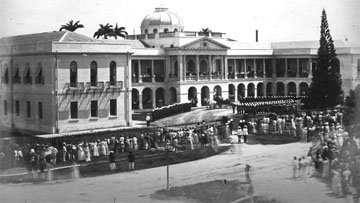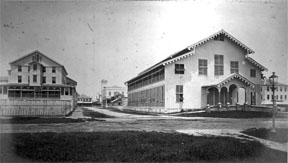Nineteenth Century Georgetown
Guyana Review reprints this essay by Eric Roberts that was first published in Kyk-Over-Al, Vol. 2, No. 7, December 1948. Kyk-Over-Al is one of this country’s oldest and most respected literary journals.
By Eric Roberts
At dawn, the city of Georgetown has the appearance of a rural village, with its many trees and palms through which peep the many towers and steeples boasting of all creeds and denominations. Here could be seen the shrines and mosques representing the religions of the East, in close proximity to the edifices of its Western neighbours, a symbol of religious tolerance.

Alongside of these are the many schools − primary and secondary − endeavouring at all times to make citizenship for the future the fundamental part of the curricula. In the City’s oldest street, Brickdam, stands the Catholic Cathedral which, destroyed by fire in 1913, has been rebuilt over an extensive area. Reminiscent of the monasteries of the Dark Ages, its grim walls, boasting of no ulterior magnificence, have ever been the centre of relief to destitute families. To the south and running in an easterly direction is the cemetery of Le Repentir:
“Each in his narrow cell forever lay,
The rude forefathers of the hamlet sleep”.

Here, among thousands of graves, within vaults and beneath marble tombstones are the remains of our City Fathers whose early exertions, vision and courage have not only helped in laying the foundation-stones, but have built on them. Here, at rest in the sublimity of the morning’s sun, they seem to be ever happy and pleased at our sturdy growth and development.
From 1782 until ’96 when it passed into British hands, the Dutch did what they could in making the new town of some importance. In the possession of the former, however, some real progress was made during the six years which followed from then until 1802, when by treaty it passed again into Dutch hands. The change in itself proved disadvantageous to the planters who, enjoying prosperity under British rule, came into ruin. It again changed hands the following year, and since then has remained British. In 1812, in honour of the Prince Regent, it assumed its present name.
The town, one mile in length, ran in an easterly direction from the river Demerara with what is now Brickdam as the centre of activity and on both sides of the road were to be found the homes, offices of government, as well as the residences of the planters. Cess-pools and quagmires were to be found in every yard, while mosquitoes and frogs were a constant nuisance to the population. Conditions of health and sanitation were negligible concerns. In 1831, the three countries − then under two separate governments − became one and, six years after, the municipality came into being.
Within a few years, some changes were made on an appreciable scale and many muddy tracks had been converted into moderate-sized streets along with the building and repairing of bridges which spanned the many canals. Slowly, with an increase of the town population, areas adjacent to what was formerly Stabroek and termed as wards, were amalgamated within the limits of the City, of which Cummingsburg and Robbstown are leading examples.
But the greatest problem to be solved by the new corporation was the encroachment of the sea on its northern coastline where were to be found the Eve Leary Barracks and the little village − Kingston. Flooding at intervals was not uncommon or infrequent in those early days.
In 1864, the municipality had its great baptism of fire which caused considerable damage to both houses and commercial centres. Impedi-ments though there were, the City continued to make sure its progress. In 1872, gas-light replaced lamps, amidst open consternation of the inhabitants, climaxed by an evening of discomfort at the Assembly Rooms when it held its first Gas-Light Ball the same year. It is here recorded by Henry Kirke, one time Sheriff of Essequibo, “the hall was swarmed with cockles and dancing was almost impossible, everywhere cockles were to be seen, on clothes as well as in the drinks”.
The final decade in the last century may be considered the most prolific period throughout the brief experience of the corporation. The Sea Wall was completed in ’92, St. George’s Cathedral was also completed and Bishop Austin celebrated his Golden Jubilee. Here, for half a century, he remains. He died the same year, at the ripe age of eighty-five, beloved by all sections of the community, head of the Anglican Church and well remembered for the tribute paid him by the Queen Victoria in 1842, as “the youngest and most handsome bishop in her dominions.”
Five years after his, the Queen celebrated her Diamond Jubilee and, as ten years earlier, the Colony joined with the rest of the Empire in the pageantry. The City recovering from the effects of earlier sufferings ran wild with jubilations, climaxed by the discovery of gold and diamonds in large quantities.
With these memorable activities, a century alive with the memories of Stabroek, then Georgetown, nurtured among vicissitudes, riots and uprisings, among epidemics and deaths, passed away within the records of history.








